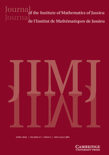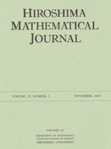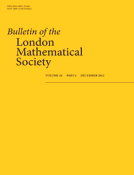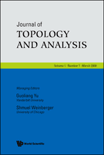
Symmetry Integrability and Geometry-Methods and Applications
Scope & Guideline
Unlocking the Secrets of Geometry and Integrability
Introduction
Aims and Scopes
- Symmetry in Mathematical Physics:
The journal emphasizes the role of symmetry in physical systems, particularly in quantum mechanics and field theories. This includes the study of symmetry groups, invariants, and their applications in solving complex physical problems. - Integrability and Solitons:
A significant focus is on integrable systems, including soliton theory, painleve equations, and their applications in mathematical physics. The journal covers both classical and quantum integrable systems and their geometric interpretations. - Geometric Structures and Analysis:
Research on geometric structures such as symplectic, Kahler, and pseudo-Kahler manifolds is prevalent. The journal also explores analytical techniques applied to these geometries, including differential equations and cohomological methods. - Algebraic and Topological Methods:
The journal publishes works that utilize algebraic and topological methods in studying geometric properties, including representations of algebras, cohomological techniques, and applications to topology. - Applications in Mathematical Physics:
There is a consistent emphasis on the applications of symmetry and geometric methods to problems in mathematical physics, including quantum mechanics, statistical mechanics, and general relativity.
Trending and Emerging
- Quantum Geometry and Noncommutative Geometry:
There is a growing interest in the interplay between quantum mechanics and geometry, particularly noncommutative geometry. This trend reflects the increasing relevance of quantum theories in understanding geometric structures. - Higher-Dimensional and Algebraic Geometry:
Research focusing on higher-dimensional geometries and their algebraic properties is on the rise. This includes the study of moduli spaces, algebraic varieties, and their applications in string theory. - Integrable Systems in Modern Physics:
The exploration of integrable systems in the context of modern theoretical physics, including applications in string theory and quantum field theory, is becoming more prominent, highlighting the relevance of integrability in contemporary research. - Symplectic Geometry and Topological Methods:
There is an increasing emphasis on symplectic geometry and its applications to topology and mathematical physics, reflecting a broader trend in the mathematical community towards these areas. - Resurgence and Quantum Modularity:
Emerging studies on resurgence phenomena and quantum modular forms are capturing attention, indicating a shift towards understanding deeper connections between quantum theories and modular forms.
Declining or Waning
- Classical Mechanics and Dynamical Systems:
The focus on classical mechanics, particularly in relation to integrable systems and dynamical systems theory, appears to be waning. This may indicate a shift toward more modern applications and theories in mathematical physics. - Nonlinear Differential Equations:
Although still present, the volume of research specifically dedicated to nonlinear differential equations has decreased, suggesting a potential shift towards more abstract algebraic and geometric approaches. - Historical Perspectives in Geometry:
Research articles exploring historical aspects of geometry and its development are less frequent. This could reflect a trend towards more contemporary issues and applications in the field. - Computational Techniques in Geometry:
The application of computational methods in geometric analysis seems to be declining, as the journal increasingly focuses on theoretical advancements rather than computational studies. - Elementary Symmetries:
Publications centered around elementary symmetry concepts, such as basic group theory applications in geometry, are less common, indicating a potential shift towards more complex and high-dimensional symmetry considerations.
Similar Journals

Journal of the Institute of Mathematics of Jussieu
Fostering Collaboration for Tomorrow's Mathematical BreakthroughsJournal of the Institute of Mathematics of Jussieu, published by Cambridge University Press, is a leading academic journal that has established itself as a vital resource in the field of mathematics. With an impressive impact factor and a ranking in the top quartile (Q1) of miscellaneous mathematics, the journal serves as a platform for high-quality research from both established scholars and emerging researchers. Spanning from 2002 to 2024, the journal aims to foster collaboration and innovation in the mathematical community by publishing original research articles, reviews, and critical discussions on a wide range of mathematical topics. Although the journal does not offer open access, it remains widely accessible through various academic institutions and libraries, ensuring that critical advancements in mathematics are shared with a global audience. Located in the United Kingdom at the prestigious Cambridge campus, the journal reflects the rigorous standards of its publisher and the rich academic tradition of its home institution.

Pure and Applied Mathematics Quarterly
Connecting Mathematicians Through Quality ResearchPure and Applied Mathematics Quarterly is a prestigious journal published by INT PRESS BOSTON, INC, focusing on the diverse and evolving field of mathematics. Since its inception in 2007, this journal has grown significantly, currently holding a Q1 ranking in the Mathematics (Miscellaneous) category for 2023, positioning it among the leading publications in the discipline. With a commitment to publishing high-quality research, Pure and Applied Mathematics Quarterly fosters innovation and dialogue within the mathematical community by providing a platform for theoretical advancements and practical applications. The journal remains accessible to researchers and professionals through its ISSN 1558-8599 and E-ISSN 1558-8602, although it does not currently offer open access. As a vital resource for mathematicians, educators, and students, this journal endeavors to expand the frontiers of mathematical knowledge and contribute to the academic dialogue surrounding this fundamental science.

MANUSCRIPTA MATHEMATICA
Fostering Innovation in Mathematical Thought.MANUSCRIPTA MATHEMATICA is an esteemed journal in the field of mathematics, published by Springer Heidelberg. Since its inception in 1969, this journal has served as a pivotal platform for disseminating high-quality research in a variety of mathematical disciplines, with a commitment to advancing knowledge and fostering collaboration among mathematicians. The journal holds a commendable impact factor and is ranked within the Q2 category for Mathematics (miscellaneous) in 2023, placing it favorably among its peers in terms of academic influence. Although open access options are not available, its rigorous peer-review process ensures that published articles maintain the highest academic standards. With a wide scope covering significant areas of general mathematics, MANUSCRIPTA MATHEMATICA not only caters to researchers and professionals seeking innovative insights but also serves as a valuable resource for students eager to deepen their understanding of mathematical theories and applications. For those looking to contribute to or stay informed about advancements in this dynamic field, the journal remains a crucial resource for literature and discourse.

Hiroshima Mathematical Journal
Advancing Mathematical Knowledge Since 1959The Hiroshima Mathematical Journal, published by Hiroshima University, Graduate School of Science, serves as a prominent platform for disseminating high-quality research in the field of mathematics. Established in 1959, the journal has been an integral part of the mathematical community, focusing on areas such as Algebra, Number Theory, Analysis, and Geometry and Topology. Although currently classified in Q4 quartile rankings within its categories, the journal is committed to advancing mathematical knowledge and fostering scholarly dialogue. Its accessibility, combined with its long-standing history, makes it an essential resource for researchers, professionals, and students dedicated to exploring and enhancing the mathematical sciences. For those interested in contributing or accessing cutting-edge research, the Hiroshima Mathematical Journal continues to uphold its mission of excellence in mathematical scholarship.

JOURNAL OF GEOMETRIC ANALYSIS
Bridging Theory and Application in GeometryJOURNAL OF GEOMETRIC ANALYSIS, published by SPRINGER, stands as a premier platform for the dissemination of high-quality research in the field of geometric analysis. With its ISSN 1050-6926 and E-ISSN 1559-002X, this prestigious journal has maintained a robust academic reputation since its inception in 1991, boasting a convergence of ideas and research that will continue through 2024. It is categorized in the top quartile (Q1) of Geometry and Topology, highlighting its significance and influence in the mathematical community. Ranking 23rd out of 106 in its field, and placing in the 78th percentile according to Scopus metrics, this publication is essential for researchers, professionals, and students who seek to deepen their understanding of geometric structures and their applications. Though it operates under a subscription model rather than Open Access, the journal consistently aims to advance knowledge through rigorous peer-reviewed articles that explore the latest developments and methodologies in geometric analysis, making it a pivotal resource for anyone involved in mathematical research.

Journal of Geometry and Symmetry in Physics
Unraveling the Geometric Fabric of the UniverseJournal of Geometry and Symmetry in Physics is a peer-reviewed academic journal dedicated to the exploration and dissemination of research at the intersection of geometry, mathematical physics, and symmetry principles. Published by the BULGARIAN ACADEMY OF SCIENCES, INSTITUTE OF MECHANICS, this journal plays a pivotal role in fostering interdisciplinary studies that leverage geometric insights to advance theoretical and applied physics. With an ISSN of 1312-5192 and an E-ISSN of 1314-5673, it serves as a crucial platform for both established and emerging researchers to share their findings. Boasting a 2023 Scopus ranking in the Q3 category for both Geometry and Topology and Mathematical Physics, the journal demonstrates its growing influence in these fields. Since its inception in 2004, it has continuously aimed to bridge gaps between mathematical theories and physical applications, welcoming contributions that enhance our understanding of fundamental symmetries and geometric structures. Though it operates without an open-access model, the journal remains committed to high-quality publishing standards, making it an essential resource for academics, practitioners, and students alike who are passionate about uncovering the mathematical fabric underlying physical phenomena.

BULLETIN OF THE LONDON MATHEMATICAL SOCIETY
Championing Scholarly Discourse in the Mathematical SciencesThe BULLETIN OF THE LONDON MATHEMATICAL SOCIETY, published by Wiley, is a distinguished journal that serves as a vital resource in the field of mathematics. With its ISSN 0024-6093 and E-ISSN 1469-2120, this journal has consistently provided a platform for innovative research and scholarly discourse since its inception in 1969. Recognized for its quality, it currently holds an impressive Q1 ranking in the mathematics category, a testament to its significance in disseminating influential findings and trends in the mathematical sciences. Researchers and practitioners can rely on the BULLETIN for its comprehensive coverage of both theoretical and applied mathematics, which caters to a diverse audience ranging from professionals to students alike. Though it does not currently offer Open Access options, its articles can be accessed through institutional subscriptions, ensuring that significant works reach the academic community effectively. With contributions that span over five decades, the journal continues to shape mathematical research and inspire future advancements in the discipline.

Journal of Topology and Analysis
Advancing the Frontiers of Topology and AnalysisJournal of Topology and Analysis, published by WORLD SCIENTIFIC PUBL CO PTE LTD, is a distinguished peer-reviewed journal that focuses on advanced topics in mathematics, specifically within the fields of topology and analysis. Established in 2009 and running through 2024, the journal is based in Singapore and strives to present cutting-edge research that contributes to the mathematical community's understanding of geometric structures and analytical theories. Holding a respected position with a Q2 ranking in Analysis and a Q3 ranking in Geometry and Topology according to the 2023 category quartiles, the journal is indexed in Scopus, where it ranks #49 in Geometry and Topology and #118 in Analysis, showcasing its significance in the scholarly landscape. The Journal of Topology and Analysis aims to foster interdisciplinary collaboration by providing a platform for researchers, professionals, and students to share innovative findings and insights. Although it does not currently offer open access, its contributions are vital for advancing knowledge in these mathematical domains.

JOURNAL OF DIFFERENTIAL GEOMETRY
Exploring innovative paths in mathematical research.JOURNAL OF DIFFERENTIAL GEOMETRY, a premier publication by INT PRESS BOSTON, INC, has established itself as a leading forum for the dissemination of high-quality research in the fields of differential geometry, algebra, and analysis. With an impressive history that spans from 1967 to 2024, this journal is recognized for its rigorous peer-reviewed articles, contributing significantly to the advancement of mathematical theories and innovative approaches. Notably, the journal boasts a Q1 ranking in key categories such as Algebra and Number Theory, Geometry and Topology, and Analysis, reflecting its pivotal role within the mathematics community. Its Scopus rankings reinforce its reputation, placing it among the top-tier journals in its respective fields, with a 97th percentile ranking in Algebra and Number Theory, further emphasizing its influence. While the journal does not offer Open Access options, it remains a critical resource for researchers, professionals, and students aiming to stay at the forefront of developments in differential geometry and related domains. Engage with groundbreaking research and explore new methodologies that are shaping the future of mathematics.

ANNALS OF GLOBAL ANALYSIS AND GEOMETRY
Advancing Research in Global Analysis and GeometryANNALS OF GLOBAL ANALYSIS AND GEOMETRY, published by Springer, stands as a prominent periodical in the fields of analysis and geometry, holding esteemed positions in the academic community with a consistent record since its inception in 1983. With an ISSN of 0232-704X and an E-ISSN of 1572-9060, this journal provides a platform for high-quality research articles that delve into the intricate relationships between geometric constructs and analytical methods. Despite the lack of open access, the journal's influence is noteworthy, evidenced by its 2023 category quartiles, achieving Q2 rankings in both Analysis and Geometry and Topology, and notable contributions to Political Science and International Relations as well. Its Scopus rankings further illustrate its impact, placing it at rank #60 in Geometry and Topology and #132 in Analysis within a competitive academic landscape. Researchers, professionals, and students alike will find ANNALS OF GLOBAL ANALYSIS AND GEOMETRY an invaluable resource for cutting-edge discoveries and scholarly discussions that push the boundaries of knowledge within these critical fields.